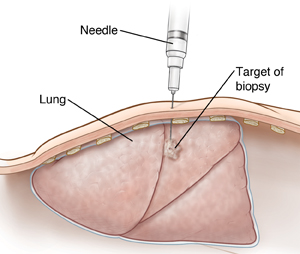CT-Guided Lung Biopsy
CT-Guided Lung Biopsy
CT-guided lung biopsy is a procedure to collect small tissue samples from an abnormal area in your lung. During the procedure, an imaging method called CT (computed tomography) is used to show live pictures of your lung. Then a thin needle is used to remove the tissue samples. The samples are tested in a lab for cancer and other problems.
Getting ready for your procedure
Follow any instructions from your healthcare provider.
Tell your provider about any medicines you are taking. It is important for your provider to know if you are taking any blood-thinning medicines or have a bleeding disorder.
You may need to stop taking all or some medicine before the procedure. This includes:
All prescription medicines
Blood-thinning medicines (anticoagulants)
Over-the-counter medicines such as aspirin or ibuprofen
Street drugs
Herbs, vitamins, and other supplements
Also tell your provider if you:
Are pregnant or think you may be pregnant
Are breastfeeding
Are allergic to or have intolerances to any medicines
Have a chronic cough, new cough, or other illness
Use oxygen therapy at home
Smoke or drink alcohol on a regular basis
Follow any directions you’re given for not eating or drinking before the procedure.
The day of your procedure
The procedure takes about 60 minutes. The entire procedure (including time to prepare and recover) takes several hours. You’ll likely go home the same day.
Before the procedure begins:
An IV (intravenous) line may be put into a vein in your hand or arm. This line supplies fluids and medicines.
To keep you free of pain during the procedure, you may be given anesthesia. Depending on the type of anesthesia used, you may be awake, drowsy, or in a deep sleep for the procedure.
During the procedure:
You’ll lie on a CT scan table. You may be on your back, side, or stomach. Pictures of your lung are then taken using the CT scanner. This helps your provider find the best place to position the needle in your lungs.
A mark is made on your skin where the needle will be inserted (biopsy site). The site is injected with numbing medicine.
Using the CT pictures as a guide, the needle is passed through the numbed skin between your ribs and into your lung. Samples of tissue are then removed from the abnormal area in your lung. The samples are sent to a lab to be checked for problems.
When the procedure is complete, the needle is removed. Pressure is applied to the biopsy site to help stop any bleeding. The site is then bandaged.
After the procedure:
You’ll be taken to a room to rest until the anesthesia wears off.
A chest X-ray may be done. This is to make sure there was no damage to your lungs or the area where the needle was placed.
When it’s time for you to go home, have an adult family member or friend ready to drive you.
Recovering at home
You may cough up a small amount of blood shortly after the procedure. Later, you may also have some soreness around the biopsy site. Once at home, follow any instructions you’re given. Be sure to:
Take all medicines as directed.
Care for the biopsy site as instructed.
Check for signs of infection at the biopsy site (see below).
Don't bathe or shower until your provider says it's OK. If you wish, you may wash with a sponge or washcloth.
Don't lift anything heavy or do strenuous activities, as directed.
If you plan any air travel, ask your provider when you can do so. You may be told not to fly for a few weeks. This is because pressure changes may affect your lungs.
When to call your healthcare provider
Call 911 or your local emergency number if you have sudden, severe difficulty breathing. This could be a life-threatening emergency.
Call your healthcare provider for less severe symptoms that are still concerning. If you are unable to speak with your provider, go to the emergency room if you have any of the following symptoms:
Fever of 100.4°F (38°C) or higher, or as directed by your healthcare provider
Sudden chest pain, shortness of breath, or fainting
Coughing up increasing amounts of blood
Signs of infection at the biopsy site, such as increased redness or swelling, warmth, more pain, bleeding, or bad-smelling drainage
Follow-up
The provider who ordered your test will discuss the biopsy results with you during a follow-up visit. Results are usually ready within 1 to 2 weeks. If more tests or treatments are needed, your provider will discuss these with you.
Risks and possible complications
An air leak in your lung (pneumothorax), which may require a stay in the hospital and treatment to re-inflate the lung
Bleeding into or around the lung
Infection in the skin or lung
Injury to other structures in the chest
Risks of anesthesia. These will be discussed with you before the procedure.
Updated:
October 07, 2017
Sources:
Procedures for tissue biopsy in patients with suspected non-small cell lung cancer. UpToDate
Reviewed By:
Blaivas, Allen J., DO,Brown, Kim, APRN
